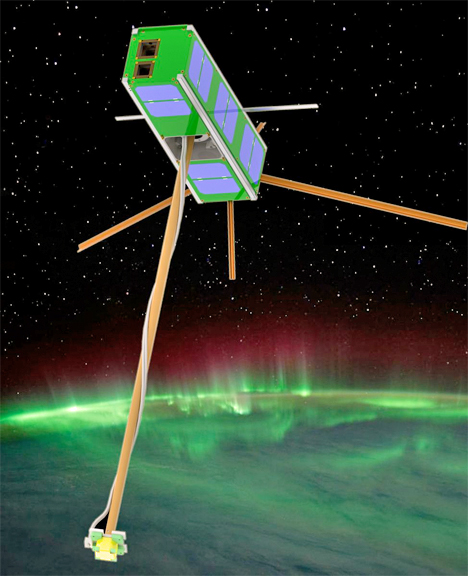
[SatNews] To conduct research on space weather, an enterprising group of UCLA undergraduates is manufacturing the first satellite built entirely on the UCLA campus.

The Electron Loss and Fields Investigation CubeSat, or ELFIN, is a tiny satellite the size of a loaf of bread that still packs the scientific punch of significantly larger, more expensive satellites. When launched, ELFIN will determine how solar wind particles and radiation behave in Earth’s environment, a topic of increasing concern because magnetic storms can wreak havoc on space infrastructure like GPS, communication and weather satellites, and even damage the electrical grid here on Earth.
"With the advent of space tourism and the increased reliance on satellites, understanding space weather is becoming increasingly important to our society," said Vassilis Angelopoulos, a professor in the UCLA Department of Earth, Planetary, and Space Sciences and ELFIN principal investigator. "We need to study the electron loss process to assemble the full picture of how space radiation is driven by solar particles."
From the beginning, ELFIN had only scant internal funding, and the outlook for completion was unclear. In spite of this uncertainty, a team of several dozen intrepid undergraduate students took on the project as their own, collectively putting in thousands of hours as a labor of love, developing and testing the satellite’s subsystems with the hope that the project would someday be fully funded. After three years of diligent work and patience, the tide finally turned in 2013 when the U.S. Air Force awarded the team a $110,000 grant to continue development and buy much-needed parts. Last February, the opportunity to achieve their goal became even more real for these space Bruins when NASA’s CubeSat Initiative and the Low-Cost Access to Space program guaranteed them a launch spot. Finally, on May 23, the team was awarded $1.2 million jointly from NASA and the National Science Foundation, ensuring enough funding to put the space-qualified hardware in orbit and to operate it for six months from the UCLA Mission Operations Center, to be located on campus.
A collaboration between the Aerospace Corporation and UCLA’s departments of Earth, Planetary and Space Sciences; Mechanical and Aerospace Engineering (MAE); and Atmospheric and Oceanic Sciences, ELFIN will benefit UCLA students, who will have the opportunity to work on a real-world space program and will also resolve a critical space physics question.
"ELFIN will train tomorrow’s leaders in space science and engineering," said Richard Wirz, a professor in the UCLA Department of Mechanical and Aerospace Engineering and a mission co-investigator. "This educational experience enables students to apply what they learn in the classroom in a hands-on, team setting and do whatever it takes to reach a scientifically compelling and challenging goal."
Drew Turner, an associate researcher in Earth, planetary and space sciences, noted that a quick-turnaround mission like this will give students the rare opportunity to see a project from conception to completion. "The ELFIN experience is unusual in comparison to an industry that typically deals with one-ton satellites that take up to 10 years to build by a veritable army of engineers," he said. "This will be an invaluable, once-in-a-lifetime opportunity for our student —a ride to space they will never forget!"
The satellite is tentatively scheduled for launch in late 2016 or early 2017 as a secondary payload, which greatly reduces the cost of reaching space. From its polar orbit approximately 370 miles overhead, ELFIN will determine how high-energy electrons in Earth’s radiation belt (located roughly 25,000 miles above the equator) are scattered out of their cyclical orbits by naturally occurring ultra-low-frequency electromagnetic waves.
Additional information is available at this infopage: http://newsroom.ucla.edu/stories/ucla-undergrads-are-first-to-build-an-entire-satellite-on-campus

